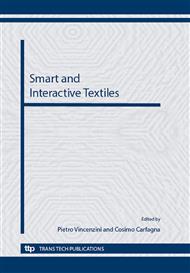[1]
R. Paradiso, G. Loriga, and N. Taccini. A wearable health care system based on knitted integrated sensors. Information Technology in Biomedicine, IEEE Transactions on, Vol. 9, No. 3, p.337–344, 2005.
DOI: 10.1109/titb.2005.854512
Google Scholar
[2]
M. Pacelli, G. Loriga, N. Taccini, and R. Paradiso. Sensing fabrics for monitoring physiological and biomechanical variables: E-textile solutions. In Medical Devices and Biosensors, 2006. 3rd IEEE/EMBS International Summer School on, p.1–4. IEEE, 2006.
DOI: 10.1109/issmdbs.2006.360082
Google Scholar
[3]
M. Di Rienzo, P. Meriggi, F. Rizzo, P. Castiglioni, C. Lombardi, M. Ferratini, and G. Parati. Textile technology for the vital signs monitoring in telemedicine and extreme environments. Information Technology in Biomedicine, IEEE Transactions on, Vol. 14, No. 3, p.711–717, 2010.
DOI: 10.1109/titb.2010.2048921
Google Scholar
[4]
F. H. Wilhelm, W. T. Roth, and M. A. Sackner. The LifeShirt. Behavior Modification, Vol. 27, No. 5, p.671–691, 2003.
Google Scholar
[5]
C. F. Clarenbach, O. Senn, T. Brack, M. Kohler, and K. E. Bloch. Monitoring of Ventilation During Exercise by a Portable Respiratory Inductive Plethysmograph. Chest, Vol. 128, No. 3, p.1282–1290, 2005.
DOI: 10.1378/chest.128.3.1282
Google Scholar
[6]
L. Kent, B. O'Neill, G. Davison, A. Nevill, J. Stuart Elborn, and J. M. Bradley. Validity and reliability of cardiorespiratory measurements recorded by the LifeShirt during exercise tests. Respiratory physiology & neurobiology, Vol. 167, No. 2, p.162–167, 2009.
DOI: 10.1016/j.resp.2009.03.013
Google Scholar
[7]
J. M. Bradley, L. Kent, B. O'Neill, A. Nevill, L. Boyle, and J. S. Elborn. Cardiorespiratory measurements during field tests in CF: Use of an ambulatory monitoring system. Pediatric pulmonology, Vol. 46, No. 3, p.253–260, 2011.
DOI: 10.1002/ppul.21360
Google Scholar
[8]
A. Lanata, E. P. Scilingo, E. Nardini, G. Loriga, R. Paradiso, and D. De-Rossi. Comparative evaluation of susceptibility to motion artifact in different wearable systems for monitoring respiratory rate. Information Technology in Biomedicine, IEEE Transactions on, Vol. 14, No. 2, p.378–386, 2010.
DOI: 10.1109/titb.2009.2037614
Google Scholar
[9]
G. Ferrigno, P. Carnevali, A. Aliverti, F. Molteni, G. Beulcke, and A. Pedotti. Three-dimensional optical analysis of chest wall motion. Journal of Applied Physiology, Vol. 77, No. 3, p.1224–1231, 1994.
DOI: 10.1152/jappl.1994.77.3.1224
Google Scholar
[10]
M. Di Rienzo, F. Rizzo, P. Meriggi, P. Castiglioni, P. Mazzoleni, G. Parati, B. Bordoni, G. Brambilla, and M. Ferratini. Magic system. Engineering in Medicine and Biology Magazine, IEEE, Vol. 28, No. 6, p.35–40, 2009.
DOI: 10.1109/memb.2009.934627
Google Scholar
[11]
B. D. Johnson, I. M. Weisman, R. J. Zeballos, and K. C. Beck. Emerging concepts in the evaluation of ventilatory limitation during exercise. Chest, Vol. 116, No. 2, p.488–503, 1999.
DOI: 10.1378/chest.116.2.488
Google Scholar


